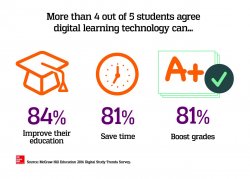Integrating Digital Media and Video into Academia
Posted in: Announcements, News

Utilizing Digital Learning Technologies (DLT) in academia is on the rise. Educators and Instructional Designers are always brainstorming ways to use visual aids in their curriculum to engage students. Videos and multimedia gives students an additional resource on the planned curriculum.
Video has become one of the most common ways people consume any type of content. Things like TV shows, movies, and even social media videos have become so ingrained in our culture that we now expect to have these things at least a few times a day. This how now translated to how students consume information in higher education. Teaching in a format that utilizes videos, or any type of media, would be familiar to the students. Students are more enthusiastic to learn and find it easier to retain information when digital media is added to the coursework.
A challenge with DLT’s in education is the hardship instructors face when creating their own content each week. Having to create videos to teach a portion of a class will be time consuming. Depending on the subject matter, the instructor may have to entirely create something new. Many professors have to update or recreate new content to match their syllabus. A time consuming process like this may add an extra workload on the instructor but will ultimately give students the extra help and clarity.

Examples of DLT’s used in classrooms today are:
-
- Video lectures
- Interactive websites
- Online modules for student learning
- Classroom blogs/forums
- Utilizing social media for assignment participation
- Lesson podcasts as part of reading/listening assignments
- Final video projects to assess students’ new knowledge of content
- Virtual Reality to help students engage in the ‘human experience’
Some instructors do not know where to start, but looking to your school or University’s Information Technology division, Instructional Technology and Design department, or other departments that provide video and digital support. At Montclair State University, the Center for the Digital Humanities provides digital support for faculty, staff and students in the College of Humanities and Social Sciences.
